Change Management Report: Hospital Development and Integration
VerifiedAdded on 2021/05/31
|13
|2613
|20
Report
AI Summary
This report examines the change management process within a hospital setting, focusing on the 'Hospital Integration in the Region of Erie' case study. It utilizes Kotter's 8-step change model to analyze the challenges and strategies involved in organizational transformation, including creating urgency, building a powerful coalition, and communicating a vision. The report addresses key issues such as resource allocation, stakeholder management, and ethical, social, and sustainability concerns. It explores how stakeholders, including board members, staff, and the ministry, are managed throughout the integration process. The conclusion emphasizes the importance of stakeholder alignment and effective leadership in successfully implementing transformational changes within the hospital environment. This report, available on Desklib, provides valuable insights into change management strategies and their application in the healthcare sector.
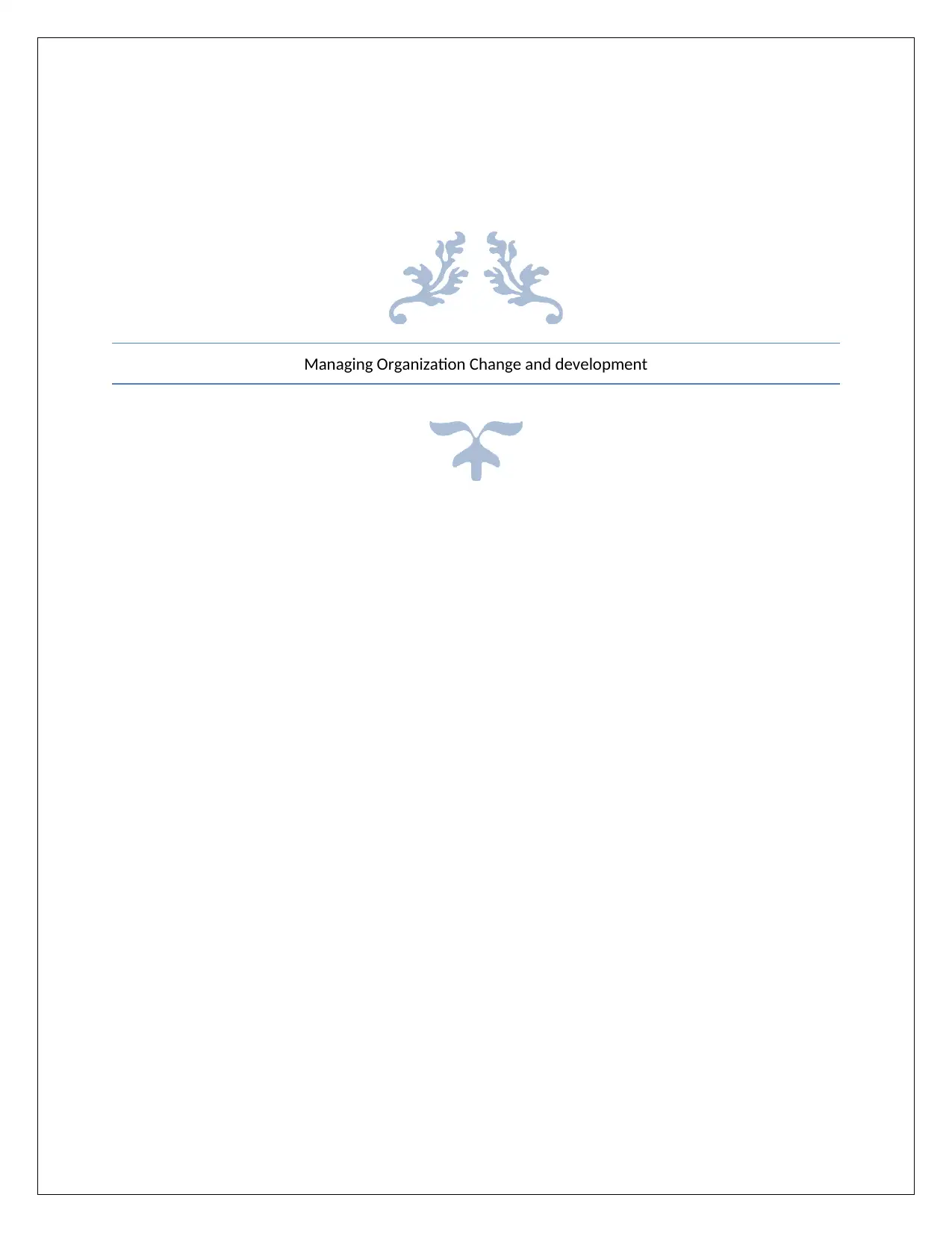
Managing Organization Change and development
Paraphrase This Document
Need a fresh take? Get an instant paraphrase of this document with our AI Paraphraser
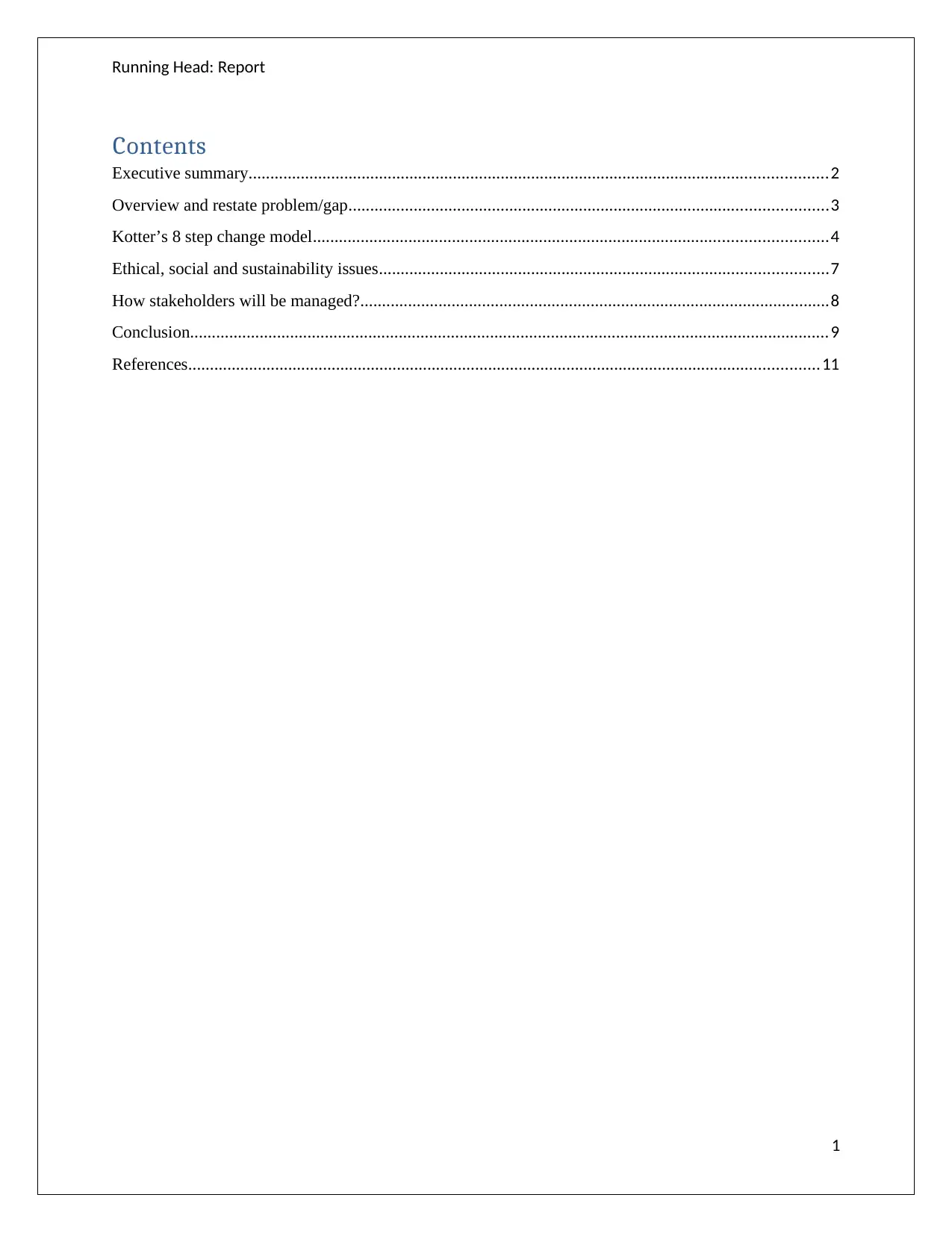
Running Head: Report
Contents
Executive summary.....................................................................................................................................2
Overview and restate problem/gap..............................................................................................................3
Kotter’s 8 step change model......................................................................................................................4
Ethical, social and sustainability issues.......................................................................................................7
How stakeholders will be managed?............................................................................................................8
Conclusion...................................................................................................................................................9
References.................................................................................................................................................11
1
Contents
Executive summary.....................................................................................................................................2
Overview and restate problem/gap..............................................................................................................3
Kotter’s 8 step change model......................................................................................................................4
Ethical, social and sustainability issues.......................................................................................................7
How stakeholders will be managed?............................................................................................................8
Conclusion...................................................................................................................................................9
References.................................................................................................................................................11
1
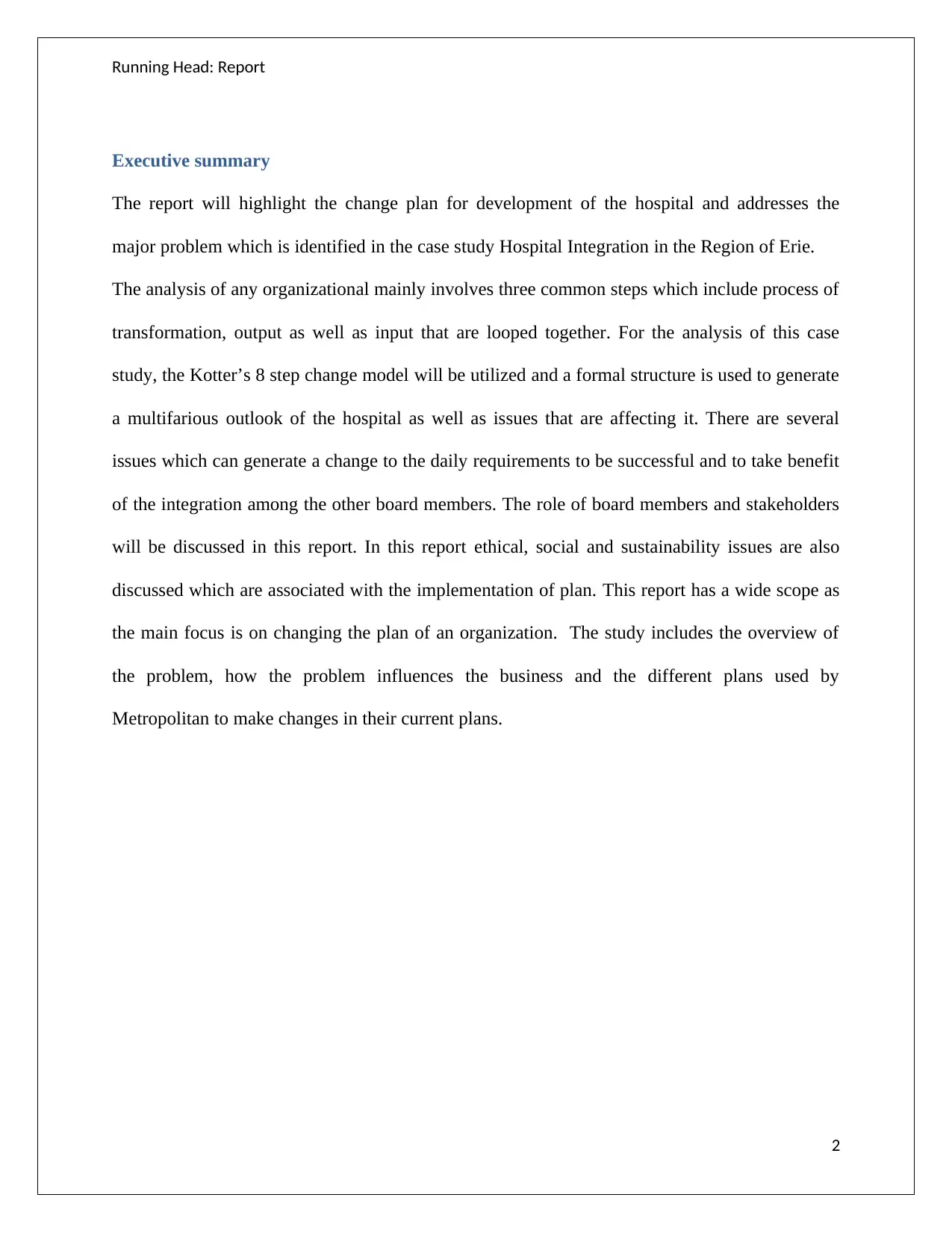
Running Head: Report
Executive summary
The report will highlight the change plan for development of the hospital and addresses the
major problem which is identified in the case study Hospital Integration in the Region of Erie.
The analysis of any organizational mainly involves three common steps which include process of
transformation, output as well as input that are looped together. For the analysis of this case
study, the Kotter’s 8 step change model will be utilized and a formal structure is used to generate
a multifarious outlook of the hospital as well as issues that are affecting it. There are several
issues which can generate a change to the daily requirements to be successful and to take benefit
of the integration among the other board members. The role of board members and stakeholders
will be discussed in this report. In this report ethical, social and sustainability issues are also
discussed which are associated with the implementation of plan. This report has a wide scope as
the main focus is on changing the plan of an organization. The study includes the overview of
the problem, how the problem influences the business and the different plans used by
Metropolitan to make changes in their current plans.
2
Executive summary
The report will highlight the change plan for development of the hospital and addresses the
major problem which is identified in the case study Hospital Integration in the Region of Erie.
The analysis of any organizational mainly involves three common steps which include process of
transformation, output as well as input that are looped together. For the analysis of this case
study, the Kotter’s 8 step change model will be utilized and a formal structure is used to generate
a multifarious outlook of the hospital as well as issues that are affecting it. There are several
issues which can generate a change to the daily requirements to be successful and to take benefit
of the integration among the other board members. The role of board members and stakeholders
will be discussed in this report. In this report ethical, social and sustainability issues are also
discussed which are associated with the implementation of plan. This report has a wide scope as
the main focus is on changing the plan of an organization. The study includes the overview of
the problem, how the problem influences the business and the different plans used by
Metropolitan to make changes in their current plans.
2
⊘ This is a preview!⊘
Do you want full access?
Subscribe today to unlock all pages.

Trusted by 1+ million students worldwide
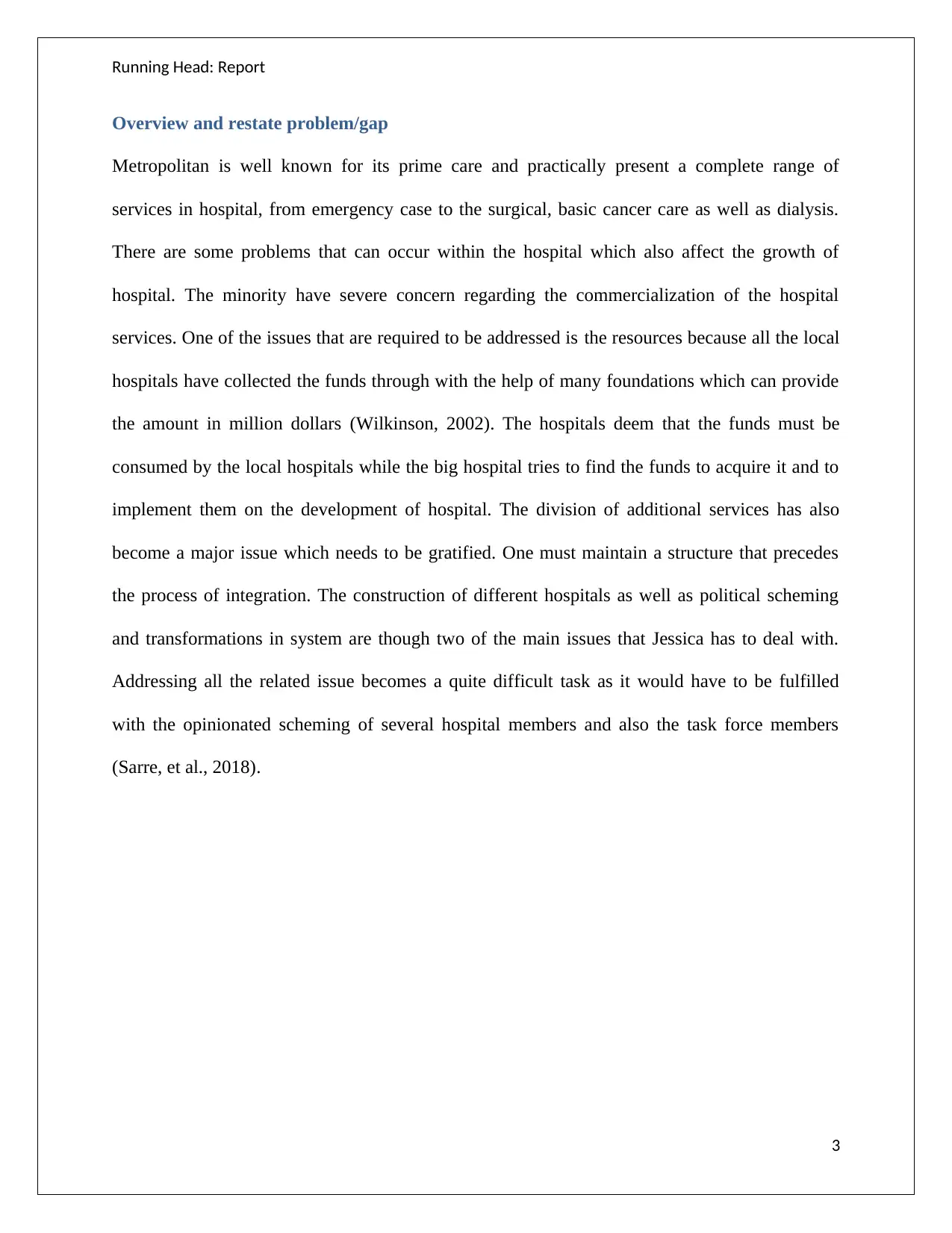
Running Head: Report
Overview and restate problem/gap
Metropolitan is well known for its prime care and practically present a complete range of
services in hospital, from emergency case to the surgical, basic cancer care as well as dialysis.
There are some problems that can occur within the hospital which also affect the growth of
hospital. The minority have severe concern regarding the commercialization of the hospital
services. One of the issues that are required to be addressed is the resources because all the local
hospitals have collected the funds through with the help of many foundations which can provide
the amount in million dollars (Wilkinson, 2002). The hospitals deem that the funds must be
consumed by the local hospitals while the big hospital tries to find the funds to acquire it and to
implement them on the development of hospital. The division of additional services has also
become a major issue which needs to be gratified. One must maintain a structure that precedes
the process of integration. The construction of different hospitals as well as political scheming
and transformations in system are though two of the main issues that Jessica has to deal with.
Addressing all the related issue becomes a quite difficult task as it would have to be fulfilled
with the opinionated scheming of several hospital members and also the task force members
(Sarre, et al., 2018).
3
Overview and restate problem/gap
Metropolitan is well known for its prime care and practically present a complete range of
services in hospital, from emergency case to the surgical, basic cancer care as well as dialysis.
There are some problems that can occur within the hospital which also affect the growth of
hospital. The minority have severe concern regarding the commercialization of the hospital
services. One of the issues that are required to be addressed is the resources because all the local
hospitals have collected the funds through with the help of many foundations which can provide
the amount in million dollars (Wilkinson, 2002). The hospitals deem that the funds must be
consumed by the local hospitals while the big hospital tries to find the funds to acquire it and to
implement them on the development of hospital. The division of additional services has also
become a major issue which needs to be gratified. One must maintain a structure that precedes
the process of integration. The construction of different hospitals as well as political scheming
and transformations in system are though two of the main issues that Jessica has to deal with.
Addressing all the related issue becomes a quite difficult task as it would have to be fulfilled
with the opinionated scheming of several hospital members and also the task force members
(Sarre, et al., 2018).
3
Paraphrase This Document
Need a fresh take? Get an instant paraphrase of this document with our AI Paraphraser
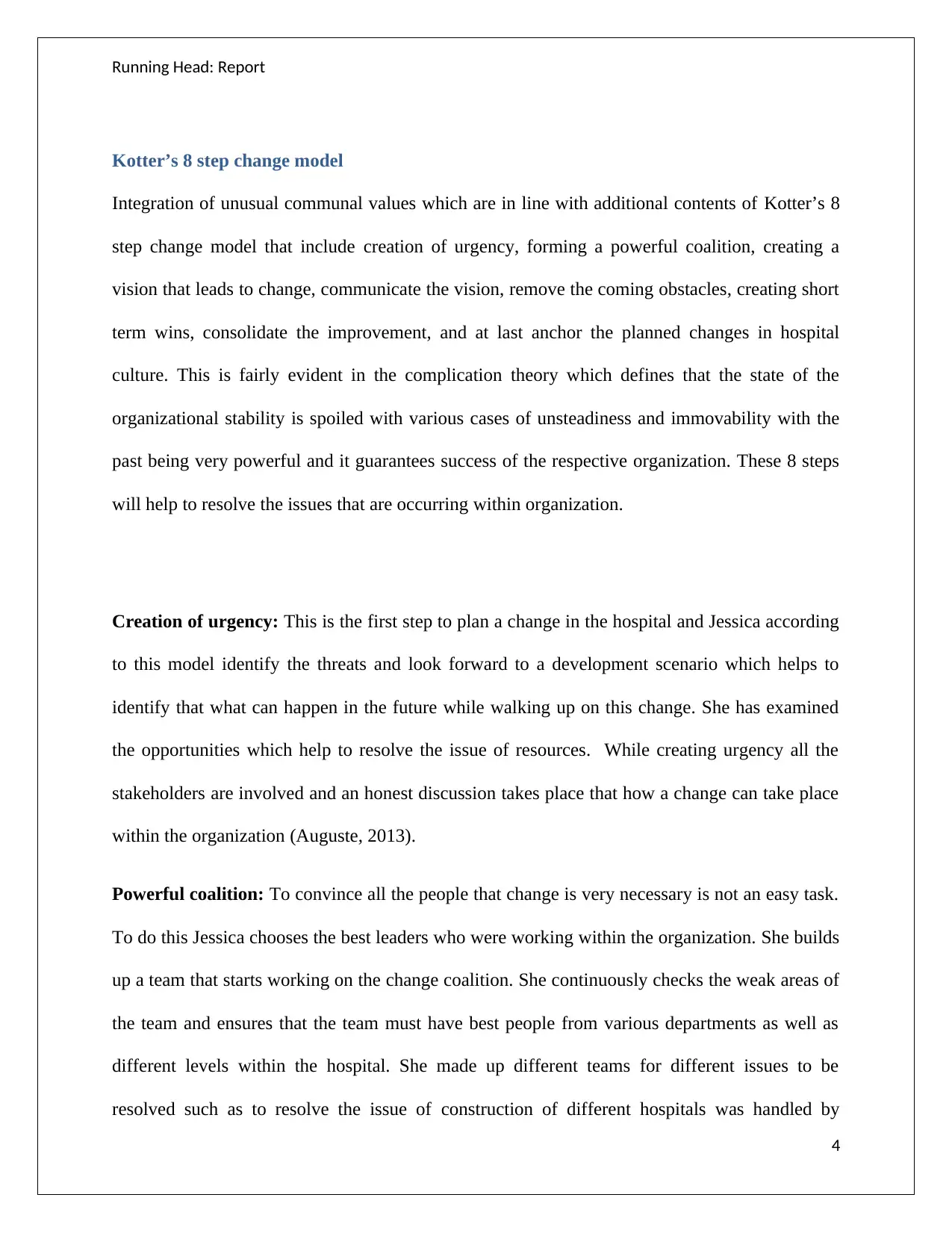
Running Head: Report
Kotter’s 8 step change model
Integration of unusual communal values which are in line with additional contents of Kotter’s 8
step change model that include creation of urgency, forming a powerful coalition, creating a
vision that leads to change, communicate the vision, remove the coming obstacles, creating short
term wins, consolidate the improvement, and at last anchor the planned changes in hospital
culture. This is fairly evident in the complication theory which defines that the state of the
organizational stability is spoiled with various cases of unsteadiness and immovability with the
past being very powerful and it guarantees success of the respective organization. These 8 steps
will help to resolve the issues that are occurring within organization.
Creation of urgency: This is the first step to plan a change in the hospital and Jessica according
to this model identify the threats and look forward to a development scenario which helps to
identify that what can happen in the future while walking up on this change. She has examined
the opportunities which help to resolve the issue of resources. While creating urgency all the
stakeholders are involved and an honest discussion takes place that how a change can take place
within the organization (Auguste, 2013).
Powerful coalition: To convince all the people that change is very necessary is not an easy task.
To do this Jessica chooses the best leaders who were working within the organization. She builds
up a team that starts working on the change coalition. She continuously checks the weak areas of
the team and ensures that the team must have best people from various departments as well as
different levels within the hospital. She made up different teams for different issues to be
resolved such as to resolve the issue of construction of different hospitals was handled by
4
Kotter’s 8 step change model
Integration of unusual communal values which are in line with additional contents of Kotter’s 8
step change model that include creation of urgency, forming a powerful coalition, creating a
vision that leads to change, communicate the vision, remove the coming obstacles, creating short
term wins, consolidate the improvement, and at last anchor the planned changes in hospital
culture. This is fairly evident in the complication theory which defines that the state of the
organizational stability is spoiled with various cases of unsteadiness and immovability with the
past being very powerful and it guarantees success of the respective organization. These 8 steps
will help to resolve the issues that are occurring within organization.
Creation of urgency: This is the first step to plan a change in the hospital and Jessica according
to this model identify the threats and look forward to a development scenario which helps to
identify that what can happen in the future while walking up on this change. She has examined
the opportunities which help to resolve the issue of resources. While creating urgency all the
stakeholders are involved and an honest discussion takes place that how a change can take place
within the organization (Auguste, 2013).
Powerful coalition: To convince all the people that change is very necessary is not an easy task.
To do this Jessica chooses the best leaders who were working within the organization. She builds
up a team that starts working on the change coalition. She continuously checks the weak areas of
the team and ensures that the team must have best people from various departments as well as
different levels within the hospital. She made up different teams for different issues to be
resolved such as to resolve the issue of construction of different hospitals was handled by
4
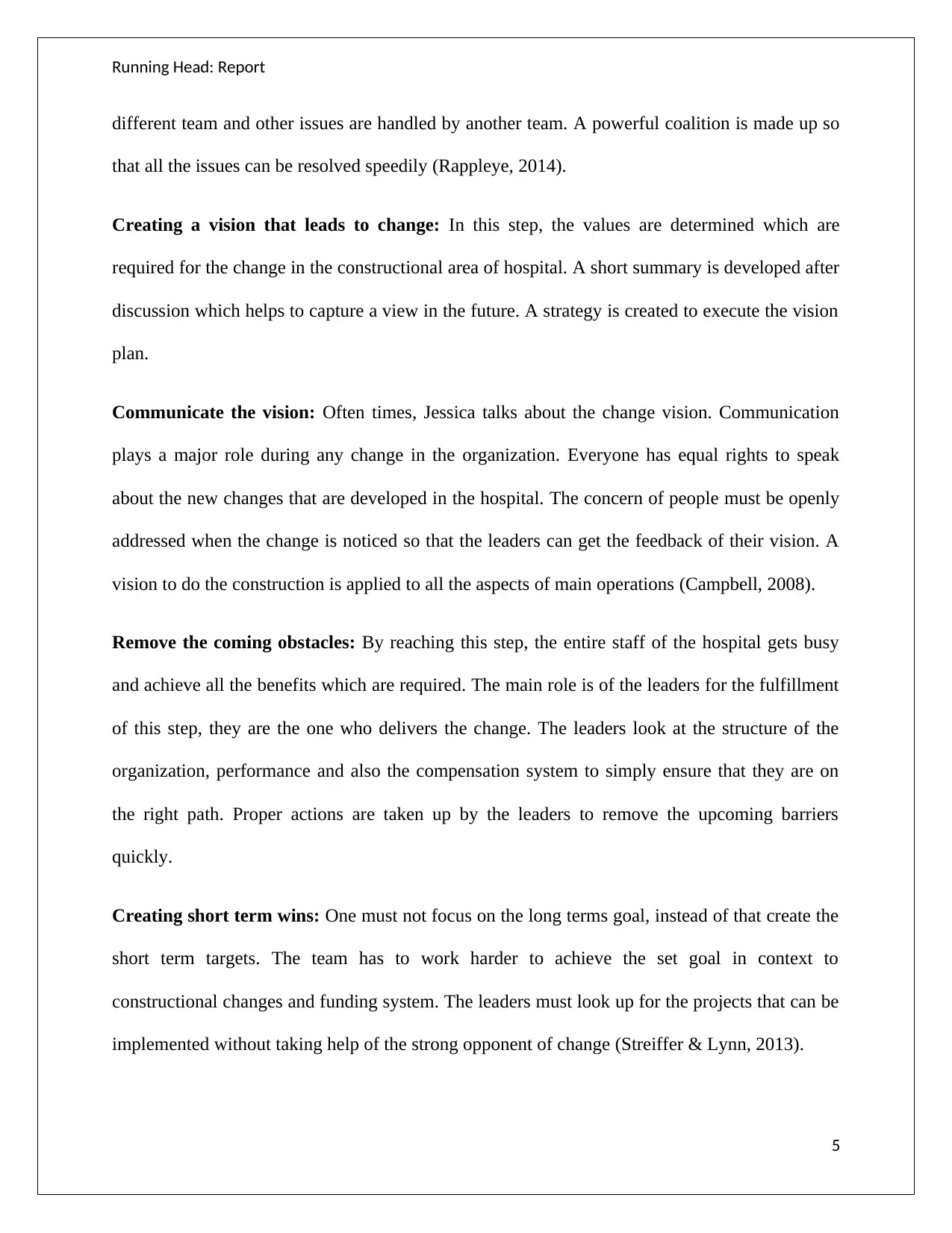
Running Head: Report
different team and other issues are handled by another team. A powerful coalition is made up so
that all the issues can be resolved speedily (Rappleye, 2014).
Creating a vision that leads to change: In this step, the values are determined which are
required for the change in the constructional area of hospital. A short summary is developed after
discussion which helps to capture a view in the future. A strategy is created to execute the vision
plan.
Communicate the vision: Often times, Jessica talks about the change vision. Communication
plays a major role during any change in the organization. Everyone has equal rights to speak
about the new changes that are developed in the hospital. The concern of people must be openly
addressed when the change is noticed so that the leaders can get the feedback of their vision. A
vision to do the construction is applied to all the aspects of main operations (Campbell, 2008).
Remove the coming obstacles: By reaching this step, the entire staff of the hospital gets busy
and achieve all the benefits which are required. The main role is of the leaders for the fulfillment
of this step, they are the one who delivers the change. The leaders look at the structure of the
organization, performance and also the compensation system to simply ensure that they are on
the right path. Proper actions are taken up by the leaders to remove the upcoming barriers
quickly.
Creating short term wins: One must not focus on the long terms goal, instead of that create the
short term targets. The team has to work harder to achieve the set goal in context to
constructional changes and funding system. The leaders must look up for the projects that can be
implemented without taking help of the strong opponent of change (Streiffer & Lynn, 2013).
5
different team and other issues are handled by another team. A powerful coalition is made up so
that all the issues can be resolved speedily (Rappleye, 2014).
Creating a vision that leads to change: In this step, the values are determined which are
required for the change in the constructional area of hospital. A short summary is developed after
discussion which helps to capture a view in the future. A strategy is created to execute the vision
plan.
Communicate the vision: Often times, Jessica talks about the change vision. Communication
plays a major role during any change in the organization. Everyone has equal rights to speak
about the new changes that are developed in the hospital. The concern of people must be openly
addressed when the change is noticed so that the leaders can get the feedback of their vision. A
vision to do the construction is applied to all the aspects of main operations (Campbell, 2008).
Remove the coming obstacles: By reaching this step, the entire staff of the hospital gets busy
and achieve all the benefits which are required. The main role is of the leaders for the fulfillment
of this step, they are the one who delivers the change. The leaders look at the structure of the
organization, performance and also the compensation system to simply ensure that they are on
the right path. Proper actions are taken up by the leaders to remove the upcoming barriers
quickly.
Creating short term wins: One must not focus on the long terms goal, instead of that create the
short term targets. The team has to work harder to achieve the set goal in context to
constructional changes and funding system. The leaders must look up for the projects that can be
implemented without taking help of the strong opponent of change (Streiffer & Lynn, 2013).
5
⊘ This is a preview!⊘
Do you want full access?
Subscribe today to unlock all pages.

Trusted by 1+ million students worldwide
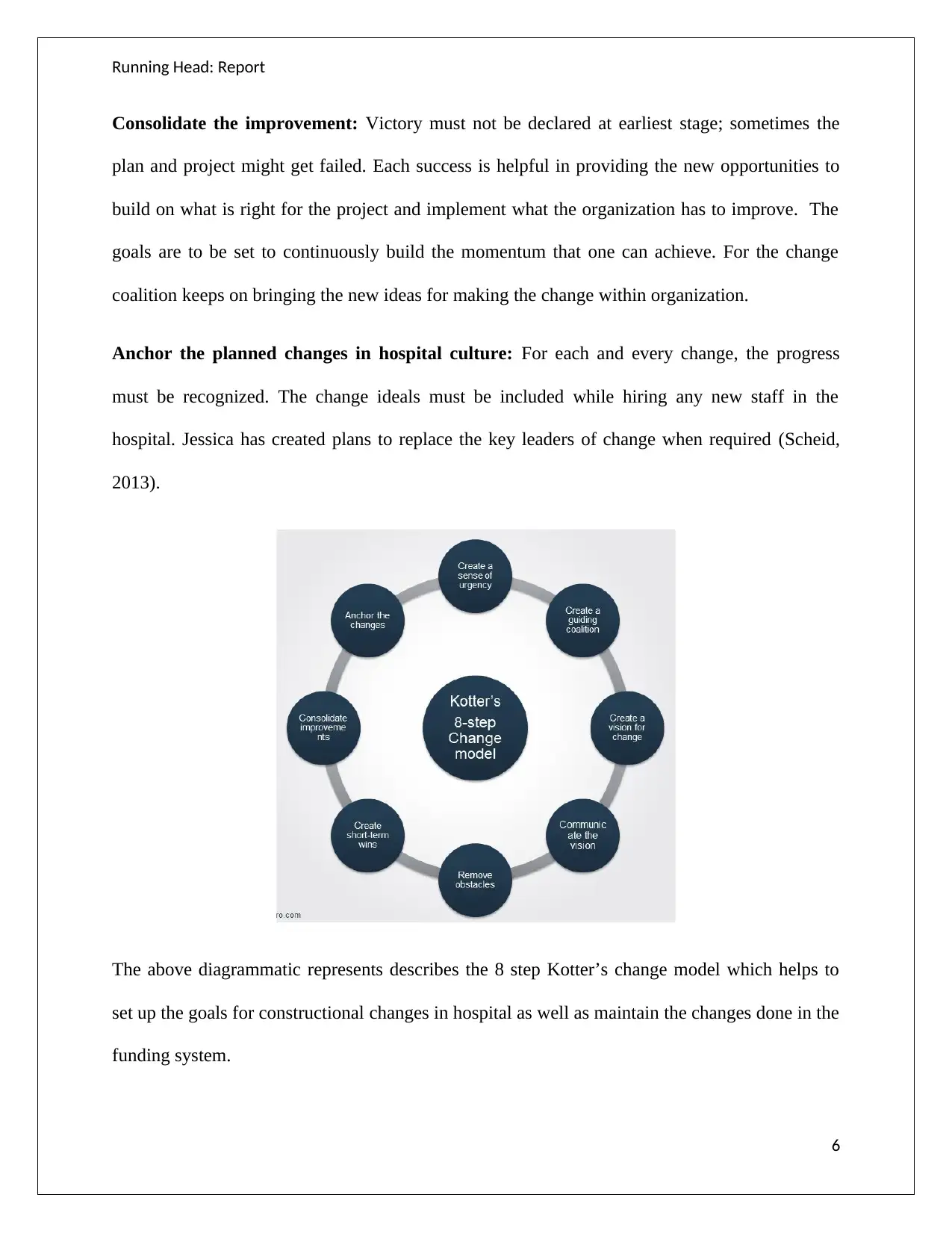
Running Head: Report
Consolidate the improvement: Victory must not be declared at earliest stage; sometimes the
plan and project might get failed. Each success is helpful in providing the new opportunities to
build on what is right for the project and implement what the organization has to improve. The
goals are to be set to continuously build the momentum that one can achieve. For the change
coalition keeps on bringing the new ideas for making the change within organization.
Anchor the planned changes in hospital culture: For each and every change, the progress
must be recognized. The change ideals must be included while hiring any new staff in the
hospital. Jessica has created plans to replace the key leaders of change when required (Scheid,
2013).
The above diagrammatic represents describes the 8 step Kotter’s change model which helps to
set up the goals for constructional changes in hospital as well as maintain the changes done in the
funding system.
6
Consolidate the improvement: Victory must not be declared at earliest stage; sometimes the
plan and project might get failed. Each success is helpful in providing the new opportunities to
build on what is right for the project and implement what the organization has to improve. The
goals are to be set to continuously build the momentum that one can achieve. For the change
coalition keeps on bringing the new ideas for making the change within organization.
Anchor the planned changes in hospital culture: For each and every change, the progress
must be recognized. The change ideals must be included while hiring any new staff in the
hospital. Jessica has created plans to replace the key leaders of change when required (Scheid,
2013).
The above diagrammatic represents describes the 8 step Kotter’s change model which helps to
set up the goals for constructional changes in hospital as well as maintain the changes done in the
funding system.
6
Paraphrase This Document
Need a fresh take? Get an instant paraphrase of this document with our AI Paraphraser
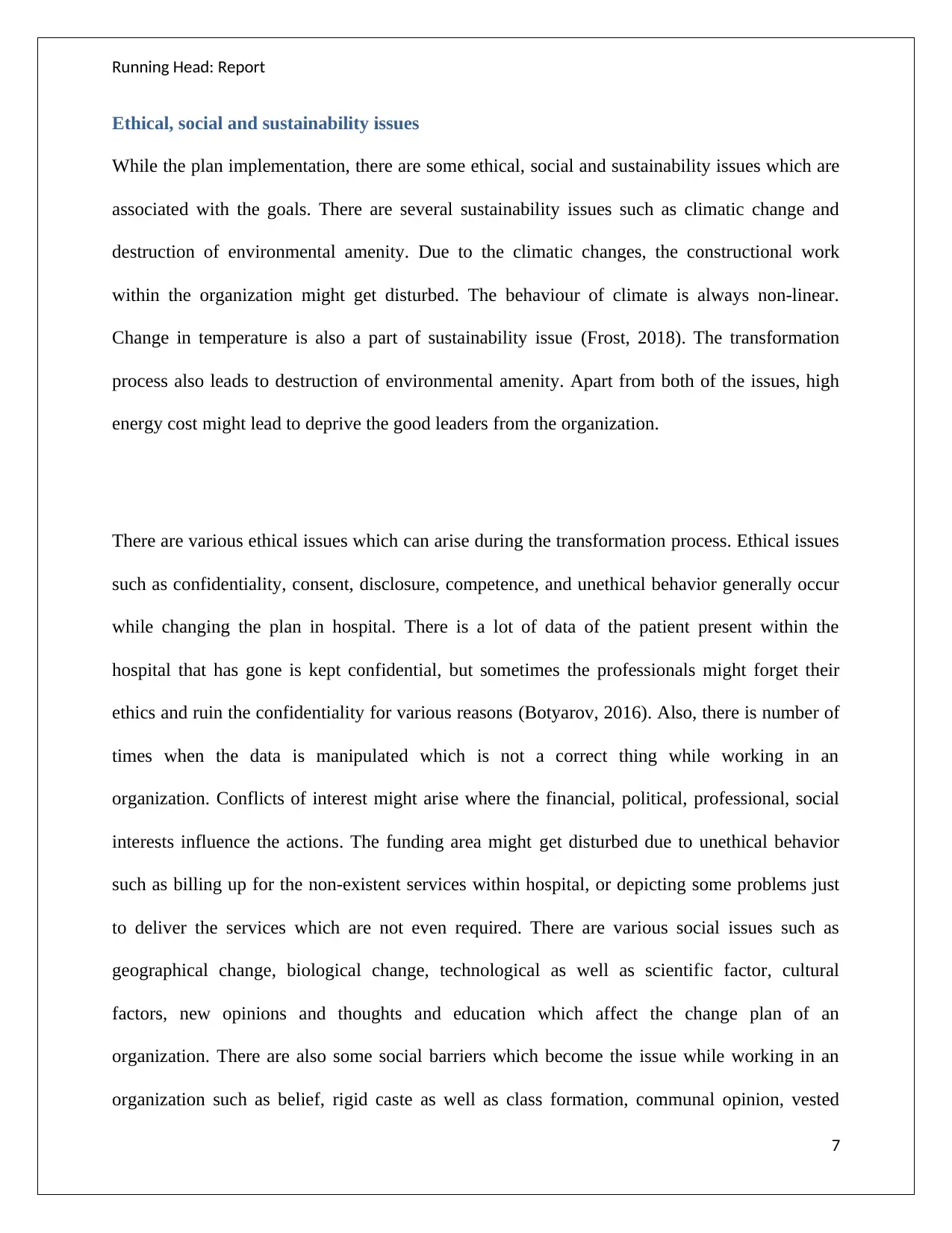
Running Head: Report
Ethical, social and sustainability issues
While the plan implementation, there are some ethical, social and sustainability issues which are
associated with the goals. There are several sustainability issues such as climatic change and
destruction of environmental amenity. Due to the climatic changes, the constructional work
within the organization might get disturbed. The behaviour of climate is always non-linear.
Change in temperature is also a part of sustainability issue (Frost, 2018). The transformation
process also leads to destruction of environmental amenity. Apart from both of the issues, high
energy cost might lead to deprive the good leaders from the organization.
There are various ethical issues which can arise during the transformation process. Ethical issues
such as confidentiality, consent, disclosure, competence, and unethical behavior generally occur
while changing the plan in hospital. There is a lot of data of the patient present within the
hospital that has gone is kept confidential, but sometimes the professionals might forget their
ethics and ruin the confidentiality for various reasons (Botyarov, 2016). Also, there is number of
times when the data is manipulated which is not a correct thing while working in an
organization. Conflicts of interest might arise where the financial, political, professional, social
interests influence the actions. The funding area might get disturbed due to unethical behavior
such as billing up for the non-existent services within hospital, or depicting some problems just
to deliver the services which are not even required. There are various social issues such as
geographical change, biological change, technological as well as scientific factor, cultural
factors, new opinions and thoughts and education which affect the change plan of an
organization. There are also some social barriers which become the issue while working in an
organization such as belief, rigid caste as well as class formation, communal opinion, vested
7
Ethical, social and sustainability issues
While the plan implementation, there are some ethical, social and sustainability issues which are
associated with the goals. There are several sustainability issues such as climatic change and
destruction of environmental amenity. Due to the climatic changes, the constructional work
within the organization might get disturbed. The behaviour of climate is always non-linear.
Change in temperature is also a part of sustainability issue (Frost, 2018). The transformation
process also leads to destruction of environmental amenity. Apart from both of the issues, high
energy cost might lead to deprive the good leaders from the organization.
There are various ethical issues which can arise during the transformation process. Ethical issues
such as confidentiality, consent, disclosure, competence, and unethical behavior generally occur
while changing the plan in hospital. There is a lot of data of the patient present within the
hospital that has gone is kept confidential, but sometimes the professionals might forget their
ethics and ruin the confidentiality for various reasons (Botyarov, 2016). Also, there is number of
times when the data is manipulated which is not a correct thing while working in an
organization. Conflicts of interest might arise where the financial, political, professional, social
interests influence the actions. The funding area might get disturbed due to unethical behavior
such as billing up for the non-existent services within hospital, or depicting some problems just
to deliver the services which are not even required. There are various social issues such as
geographical change, biological change, technological as well as scientific factor, cultural
factors, new opinions and thoughts and education which affect the change plan of an
organization. There are also some social barriers which become the issue while working in an
organization such as belief, rigid caste as well as class formation, communal opinion, vested
7
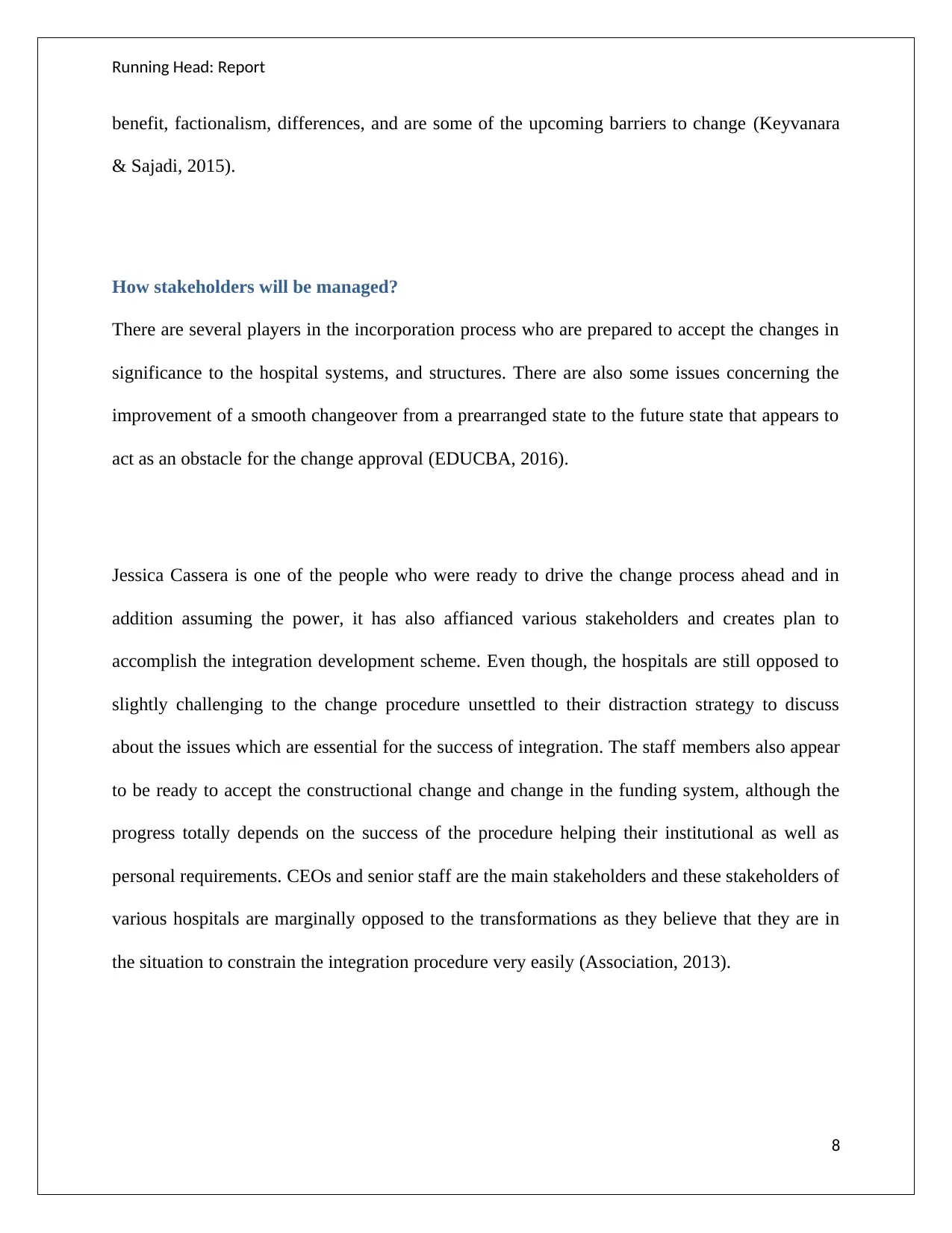
Running Head: Report
benefit, factionalism, differences, and are some of the upcoming barriers to change (Keyvanara
& Sajadi, 2015).
How stakeholders will be managed?
There are several players in the incorporation process who are prepared to accept the changes in
significance to the hospital systems, and structures. There are also some issues concerning the
improvement of a smooth changeover from a prearranged state to the future state that appears to
act as an obstacle for the change approval (EDUCBA, 2016).
Jessica Cassera is one of the people who were ready to drive the change process ahead and in
addition assuming the power, it has also affianced various stakeholders and creates plan to
accomplish the integration development scheme. Even though, the hospitals are still opposed to
slightly challenging to the change procedure unsettled to their distraction strategy to discuss
about the issues which are essential for the success of integration. The staff members also appear
to be ready to accept the constructional change and change in the funding system, although the
progress totally depends on the success of the procedure helping their institutional as well as
personal requirements. CEOs and senior staff are the main stakeholders and these stakeholders of
various hospitals are marginally opposed to the transformations as they believe that they are in
the situation to constrain the integration procedure very easily (Association, 2013).
8
benefit, factionalism, differences, and are some of the upcoming barriers to change (Keyvanara
& Sajadi, 2015).
How stakeholders will be managed?
There are several players in the incorporation process who are prepared to accept the changes in
significance to the hospital systems, and structures. There are also some issues concerning the
improvement of a smooth changeover from a prearranged state to the future state that appears to
act as an obstacle for the change approval (EDUCBA, 2016).
Jessica Cassera is one of the people who were ready to drive the change process ahead and in
addition assuming the power, it has also affianced various stakeholders and creates plan to
accomplish the integration development scheme. Even though, the hospitals are still opposed to
slightly challenging to the change procedure unsettled to their distraction strategy to discuss
about the issues which are essential for the success of integration. The staff members also appear
to be ready to accept the constructional change and change in the funding system, although the
progress totally depends on the success of the procedure helping their institutional as well as
personal requirements. CEOs and senior staff are the main stakeholders and these stakeholders of
various hospitals are marginally opposed to the transformations as they believe that they are in
the situation to constrain the integration procedure very easily (Association, 2013).
8
⊘ This is a preview!⊘
Do you want full access?
Subscribe today to unlock all pages.

Trusted by 1+ million students worldwide
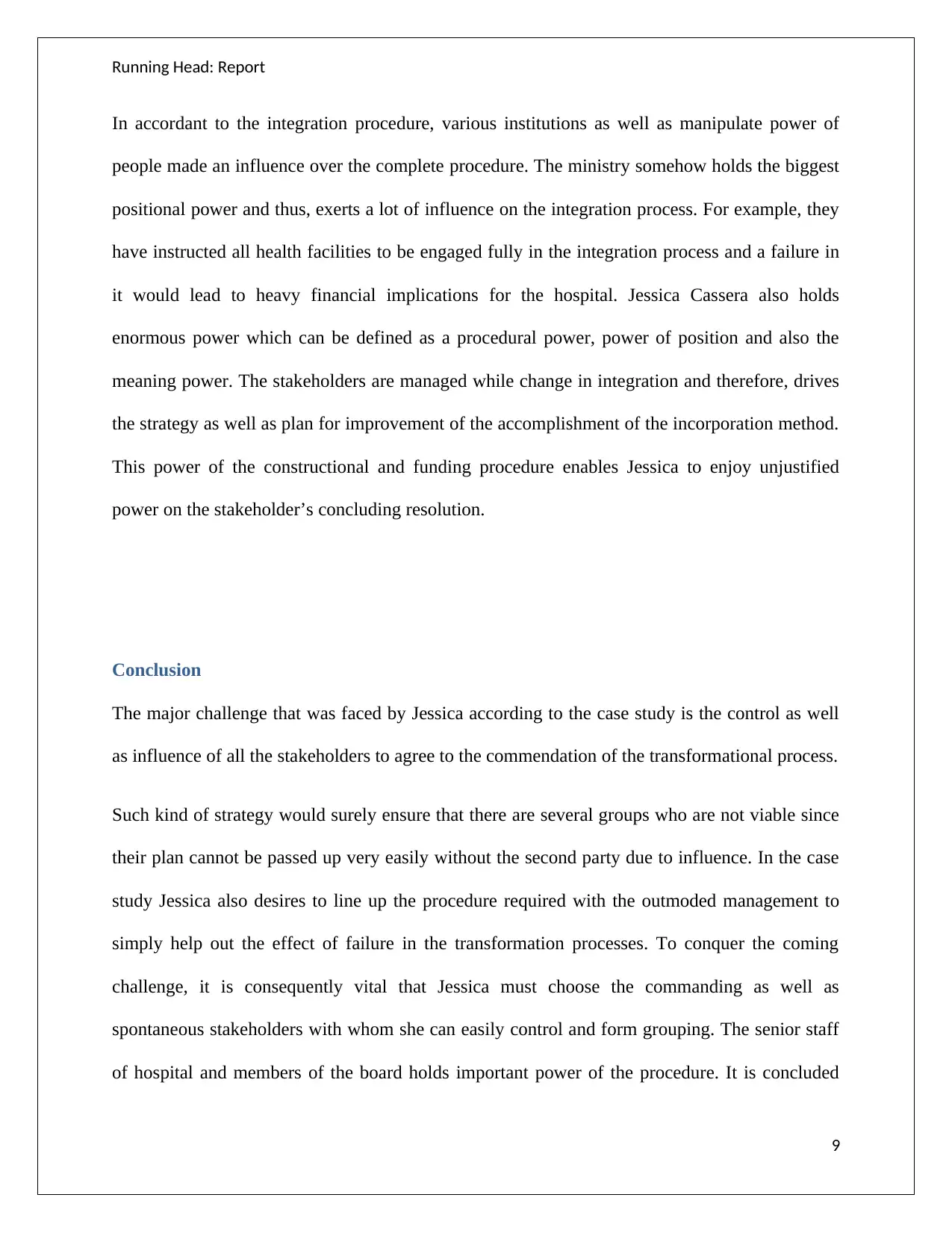
Running Head: Report
In accordant to the integration procedure, various institutions as well as manipulate power of
people made an influence over the complete procedure. The ministry somehow holds the biggest
positional power and thus, exerts a lot of influence on the integration process. For example, they
have instructed all health facilities to be engaged fully in the integration process and a failure in
it would lead to heavy financial implications for the hospital. Jessica Cassera also holds
enormous power which can be defined as a procedural power, power of position and also the
meaning power. The stakeholders are managed while change in integration and therefore, drives
the strategy as well as plan for improvement of the accomplishment of the incorporation method.
This power of the constructional and funding procedure enables Jessica to enjoy unjustified
power on the stakeholder’s concluding resolution.
Conclusion
The major challenge that was faced by Jessica according to the case study is the control as well
as influence of all the stakeholders to agree to the commendation of the transformational process.
Such kind of strategy would surely ensure that there are several groups who are not viable since
their plan cannot be passed up very easily without the second party due to influence. In the case
study Jessica also desires to line up the procedure required with the outmoded management to
simply help out the effect of failure in the transformation processes. To conquer the coming
challenge, it is consequently vital that Jessica must choose the commanding as well as
spontaneous stakeholders with whom she can easily control and form grouping. The senior staff
of hospital and members of the board holds important power of the procedure. It is concluded
9
In accordant to the integration procedure, various institutions as well as manipulate power of
people made an influence over the complete procedure. The ministry somehow holds the biggest
positional power and thus, exerts a lot of influence on the integration process. For example, they
have instructed all health facilities to be engaged fully in the integration process and a failure in
it would lead to heavy financial implications for the hospital. Jessica Cassera also holds
enormous power which can be defined as a procedural power, power of position and also the
meaning power. The stakeholders are managed while change in integration and therefore, drives
the strategy as well as plan for improvement of the accomplishment of the incorporation method.
This power of the constructional and funding procedure enables Jessica to enjoy unjustified
power on the stakeholder’s concluding resolution.
Conclusion
The major challenge that was faced by Jessica according to the case study is the control as well
as influence of all the stakeholders to agree to the commendation of the transformational process.
Such kind of strategy would surely ensure that there are several groups who are not viable since
their plan cannot be passed up very easily without the second party due to influence. In the case
study Jessica also desires to line up the procedure required with the outmoded management to
simply help out the effect of failure in the transformation processes. To conquer the coming
challenge, it is consequently vital that Jessica must choose the commanding as well as
spontaneous stakeholders with whom she can easily control and form grouping. The senior staff
of hospital and members of the board holds important power of the procedure. It is concluded
9
Paraphrase This Document
Need a fresh take? Get an instant paraphrase of this document with our AI Paraphraser
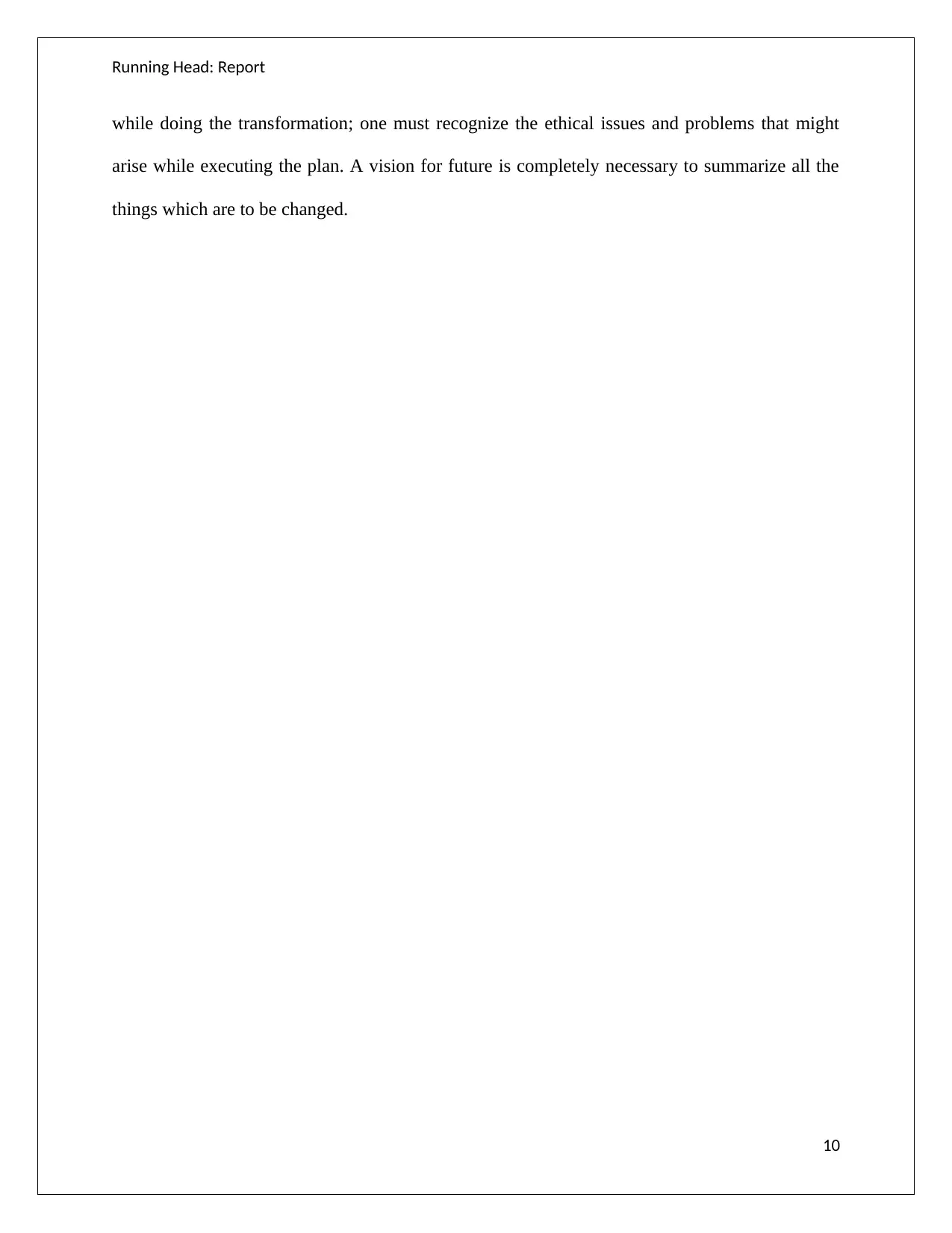
Running Head: Report
while doing the transformation; one must recognize the ethical issues and problems that might
arise while executing the plan. A vision for future is completely necessary to summarize all the
things which are to be changed.
10
while doing the transformation; one must recognize the ethical issues and problems that might
arise while executing the plan. A vision for future is completely necessary to summarize all the
things which are to be changed.
10
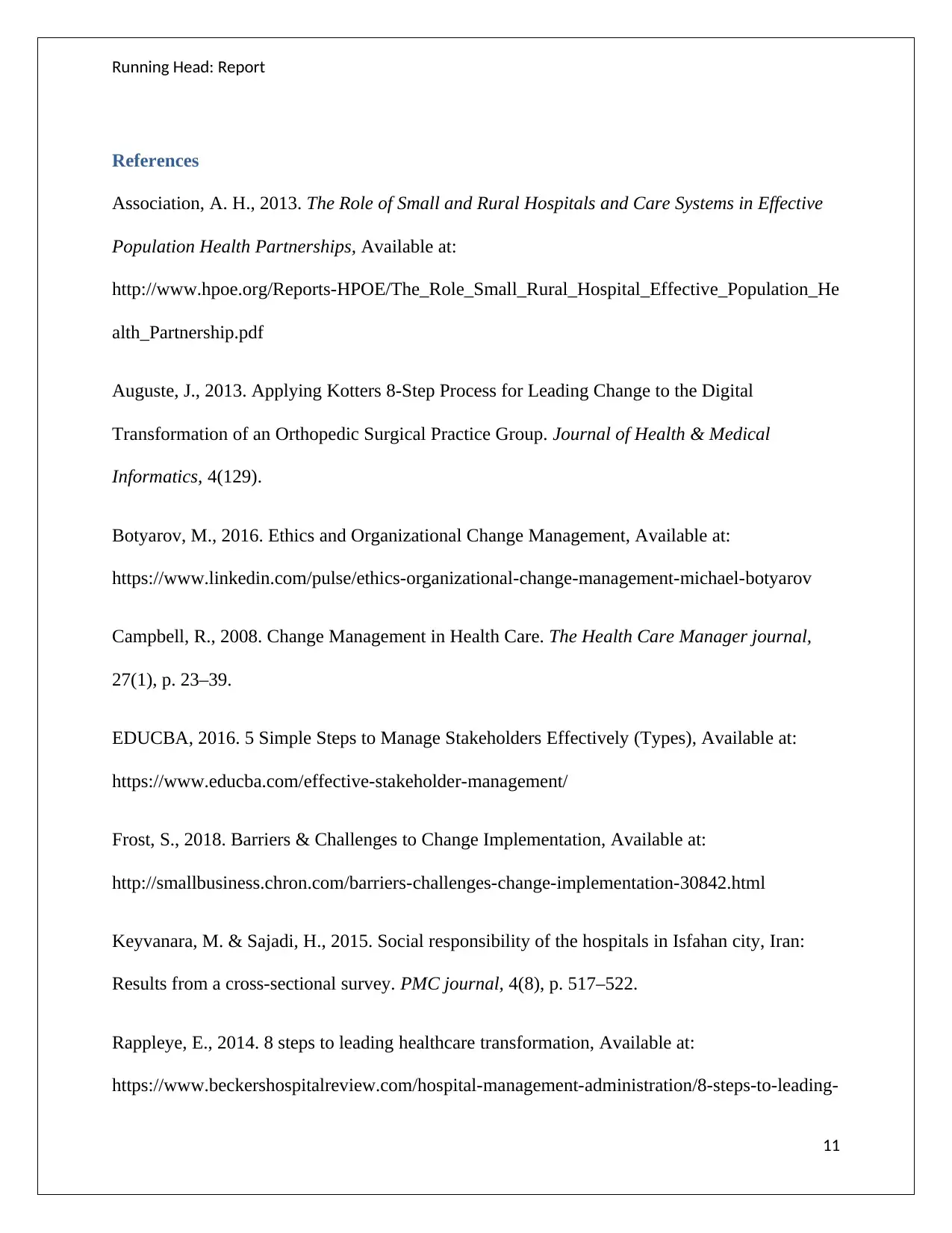
Running Head: Report
References
Association, A. H., 2013. The Role of Small and Rural Hospitals and Care Systems in Effective
Population Health Partnerships, Available at:
http://www.hpoe.org/Reports-HPOE/The_Role_Small_Rural_Hospital_Effective_Population_He
alth_Partnership.pdf
Auguste, J., 2013. Applying Kotters 8-Step Process for Leading Change to the Digital
Transformation of an Orthopedic Surgical Practice Group. Journal of Health & Medical
Informatics, 4(129).
Botyarov, M., 2016. Ethics and Organizational Change Management, Available at:
https://www.linkedin.com/pulse/ethics-organizational-change-management-michael-botyarov
Campbell, R., 2008. Change Management in Health Care. The Health Care Manager journal,
27(1), p. 23–39.
EDUCBA, 2016. 5 Simple Steps to Manage Stakeholders Effectively (Types), Available at:
https://www.educba.com/effective-stakeholder-management/
Frost, S., 2018. Barriers & Challenges to Change Implementation, Available at:
http://smallbusiness.chron.com/barriers-challenges-change-implementation-30842.html
Keyvanara, M. & Sajadi, H., 2015. Social responsibility of the hospitals in Isfahan city, Iran:
Results from a cross-sectional survey. PMC journal, 4(8), p. 517–522.
Rappleye, E., 2014. 8 steps to leading healthcare transformation, Available at:
https://www.beckershospitalreview.com/hospital-management-administration/8-steps-to-leading-
11
References
Association, A. H., 2013. The Role of Small and Rural Hospitals and Care Systems in Effective
Population Health Partnerships, Available at:
http://www.hpoe.org/Reports-HPOE/The_Role_Small_Rural_Hospital_Effective_Population_He
alth_Partnership.pdf
Auguste, J., 2013. Applying Kotters 8-Step Process for Leading Change to the Digital
Transformation of an Orthopedic Surgical Practice Group. Journal of Health & Medical
Informatics, 4(129).
Botyarov, M., 2016. Ethics and Organizational Change Management, Available at:
https://www.linkedin.com/pulse/ethics-organizational-change-management-michael-botyarov
Campbell, R., 2008. Change Management in Health Care. The Health Care Manager journal,
27(1), p. 23–39.
EDUCBA, 2016. 5 Simple Steps to Manage Stakeholders Effectively (Types), Available at:
https://www.educba.com/effective-stakeholder-management/
Frost, S., 2018. Barriers & Challenges to Change Implementation, Available at:
http://smallbusiness.chron.com/barriers-challenges-change-implementation-30842.html
Keyvanara, M. & Sajadi, H., 2015. Social responsibility of the hospitals in Isfahan city, Iran:
Results from a cross-sectional survey. PMC journal, 4(8), p. 517–522.
Rappleye, E., 2014. 8 steps to leading healthcare transformation, Available at:
https://www.beckershospitalreview.com/hospital-management-administration/8-steps-to-leading-
11
⊘ This is a preview!⊘
Do you want full access?
Subscribe today to unlock all pages.

Trusted by 1+ million students worldwide
1 out of 13
Related Documents
Your All-in-One AI-Powered Toolkit for Academic Success.
+13062052269
info@desklib.com
Available 24*7 on WhatsApp / Email
![[object Object]](/_next/static/media/star-bottom.7253800d.svg)
Unlock your academic potential
Copyright © 2020–2025 A2Z Services. All Rights Reserved. Developed and managed by ZUCOL.




